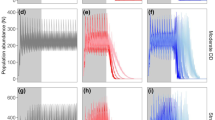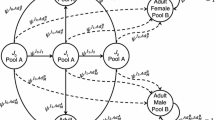Abstract
The effect of delaying female mating on population growth in codling moth (Cydia pomonella (L.)) was found to act on a physiological time (degree-day) basis and was predictable using a simple quadratic equation. When combined with previous work on degree-day based mortality, we were able to evaluate how the magnitude of population reduction and survival varied between sites, years, and generations at locations in California, Michigan, Pennsylvania and Washington states. In general, reductions in population growth associated with females mating 1–3 days after emergence were greater in warmer areas and during warmer times of the year. In any given year and location, the temperature profiles during peak flight were crucial in determining the population reductions, but over an 11-year period, the average seasonal temperature profile was more important. During the overwintering generation, conditions were relatively mild in all locations and only minor differences were observed in population growth rates between locations. Populations experiencing 1–3 days delay in female mating were reduced 8, 19 and 32 % compared to populations experiencing no delay, respectively. During the first summer generation, population reductions doubled compared to those seen in the overwintering generation. During the second summer flight, reductions in population growth rate at the three cooler locations decreased, while they increased in the warmer California location. Overall, the results show delayed mating can help understand how population growth is related to environmental conditions experienced naturally by insect populations and will help guide studies of the mechanisms of mating disruption, a technique used for pest suppression in agricultural and forest systems.






Similar content being viewed by others
References
Agnello AM, Reissig WH, Spangler SM, Charlton RE, Kain DP (1996) Trap response and fruit damage by obliquebanded leafroller (Lepidoptera: Tortricideae) in pheromone-treated apple orchards in New York. Environ Entomol 25:268–282
Barclay HJ, Judd GJR (1995) Models for mating disruption by means of pheromone for insect pest control. Res Popul Ecol 37:239–247
Bartell RJ (1982) Mechanisms of communication disruption by pheromone in the control of Lepidoptera: a review. Physiol Entomol 7:353–364
Baskerville GL, Emin P (1969) Rapid estimation of heat accumulation from maximum and minimum temperatures. Ecology 50:514–516
Batiste WC, Olson WH, Berlowitz A (1973) Codling moth: influence of temperature and daylight intensity on periodicity of daily flight in the field. J Econ Entomol 66:883–892
Carde RT, Minks AK (1995) Control of moth pests by mating disruption: successes and constraints. Annu Rev Entomol 40:559–585
Carey JR (1993) Applied demography for biologists with special emphasis on insects. Oxford University Press, NY
Carey JR (2001) Insect biodemography. Annu Rev Entomol 46:79–110
Caswell H (2001) Matrix population models, 2nd edn. Sinauer Assoc., Inc., Sunderland
Fadamiro HY, Cosse AA, Baker TC (1999) Mating disruption of European corn borer, Ostrinia nubilalis, by using two types of sex pheromone dispensers deployed in grassy aggregation sites in Iowa cornfields. J Asia-Pac Entomol 2:121–132
Howell FJ, Neven LG (2000) Physiological development time and zero development temperatures of the codling moth (Lepidoptera: Tortricidae). Environ Entomol 29:766–772
Jones VP, Aihara-Sasaki M (2001) Demographic analysis of delayed mating in mating disruption: a case study with Cryptophlebia illepida (Lepidoptera: Tortricidae). J Econ Entomol 94:785–792
Jones VP, Wiman NG (2008) Longevity of adult codling moth and obliquebanded leafroller in Washington apple orchards. J Ins Sci 8:10
Jones VP, Wiman NG, Brunner JF (2008a) Comparison of delayed female mating on reproductive biology of codling moth and obliquebanded leafroller. Environ Entomol 37:679–685
Jones VP, Doerr MD, Brunner JF (2008b) Is biofix necessary for predicting codling moth emergence in Washington State apple orchards? J Econ Entomol 101:1651–1657
Knight AL (1996) Why so many mated female codling moths in disrupted orchards? Proc Wash St Hort Assoc 92:213–214
Knight AL (2000) Monitoring codling moth (Lepidoptera: Tortricidae) with passive interception traps in sex pheromone-treated apple orchards. J Econ Entomol 93:1744–1751
Knight AL (2007) Multiple mating of male and female codling moth (Lepidoptera: Tortricidae) in apple orchards treated with sex pheromone. Environ Entomol 36:157–164
Knight AL, Cockfield S, Thomson D, Neff D (1996) Developing mating disruption for leafrollers. Proc Wash St Hort Assoc 92:211–212
Lawson DS, Reissig WH, Agnello AM, Nyrop JP, Roelofs WL (1996) Interference with the mate-finding communication system of the obliquebanded leafroller (Lepidoptera: Tortricidae) using synthetic sex pheromones. Environ Entomol 25:895–905
Lewontin RC (1965) Selection for colonizing ability. In: Baker AG, Stebbins GL (eds) The genetics of colonizing species. Academic Press, NY, pp 77–94
Pitcairn MJ, Pickel C, Falcon LA, Zalom FG (1991) Development and survivorship of Cydia pomonella (L.) (Lepidoptera: Tortricidae) at ten constant temperatures. Pan Pac Entomol 67:189–194
Riedl H, Croft BA (1978) The effects of photoperiod and effective temperatures on the seasonal phenology of the codling moth (Lepidoptera: Tortricidae). Can Entomol 110:455–470
Riedl H, Croft BA, Howitt AJ (1976) Forecasting codling moth phenology based on pheromone trap catches and physiological-time models. Can Entomol 108:449–460
Robinet C, Liebhold AM, Gray D (2007) Variation in developmental time affects mating success and Allee effects. Oikos 116:1227–1237
SAS Institute Inc (2010) JMP statistics and graphics guide. Version 9.02. SAS Institute Inc, Cary
Welch SM, Croft BA, Brunner JF, Michels MF (1978) PETE: an extension phenology modeling system for management of multi-species pest complex. Environ Entomol 7:487–494
Wong TTY, Cleveland ML, Ralston DF, Davis DG (1971) Time of sexual activity of codling moths in the field. J Econ Entomol 64:553–554
Acknowledgments
We thank Ute Chambers of the Department of Entomology at Washington State University Tree Fruit Research and Extension Center, Steve Welter and Nick Mills of the Department of Environmental Science and Policy Management at UC Berkeley for reviews of previous versions. Data contributed by Walt Bentley, UC IPM and Larry Hull, Department of Entomology, Penn State University on the flight of codling moth in Arvin and Biglerville, respectively, is gratefully appreciated. The assistance of Pauline Anderson, USDA-ARS Wapato, in providing codling moth for the experiments is greatly appreciated. This work funded by grants to VPJ from the Washington Tree Fruit Research Commission.
Author information
Authors and Affiliations
Corresponding author
Rights and permissions
About this article
Cite this article
Jones, V.P., Wiman, N.G. Modeling the interaction of physiological time, seasonal weather patterns, and delayed mating on population dynamics of codling moth, Cydia pomonella (L.) (Lepidoptera: Tortricidae). Popul Ecol 54, 421–429 (2012). https://doi.org/10.1007/s10144-012-0315-8
Received:
Accepted:
Published:
Issue Date:
DOI: https://doi.org/10.1007/s10144-012-0315-8




